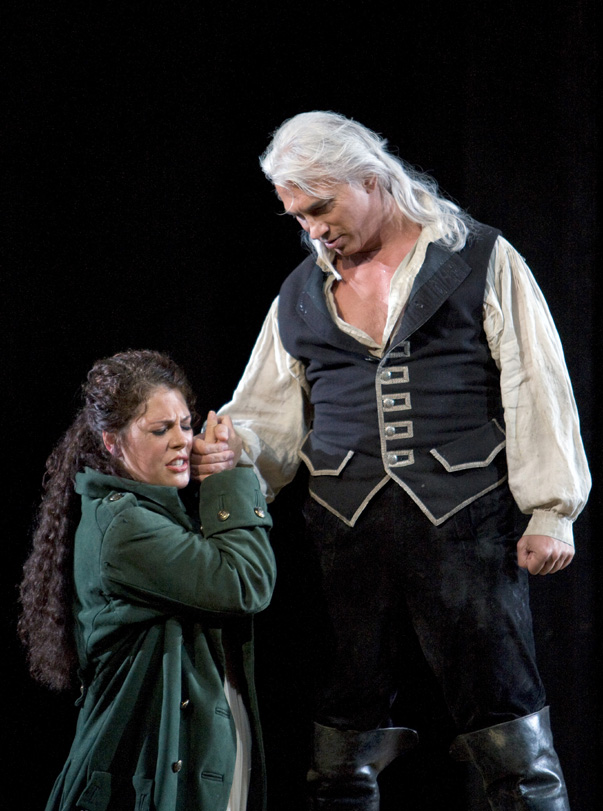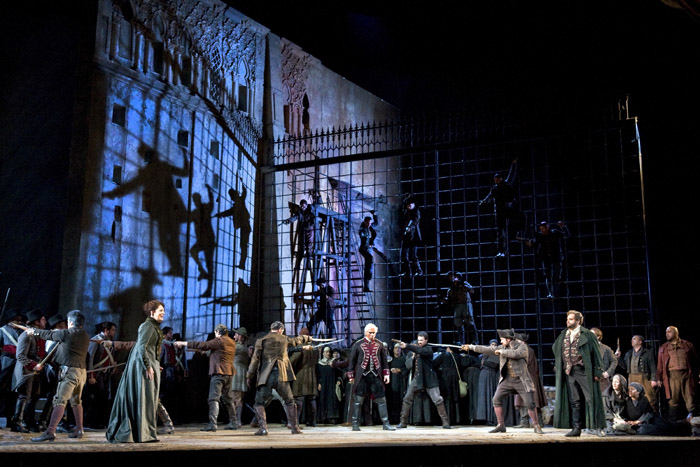 It’s all about the voice …
It’s all about the voice …
There’s nothing quite like hearing seriously talented singers take on Verdi’s Il Trovatore. With each stunning recitative, cavatina, or aria, the ante is raised, and the next singer must match it or drop out of game for the audience’s attention. In the San Francisco Opera’s opening production of the season, all the singers were playing to win.
With the first long plot explanation by Ferrando, sung by bass Burak Bilgili with powerful and gripping vigor, it was clear that this was going to be a production thrilling with music and gleaming with emotional brilliance.
In her impressive San Francisco debut, soprano Sondra Radvanovsky sang Leonora. She has a gorgeous, warm and sensuous voice; endowed with a big big voice, she has consummate control of its dynamics. Several times throughout Verdi’s score, she moved from forte to pianissimo, and it was as if she was peeling layers from her opulent and tonally concentrated voice until only a thin crystal filament was left, shimmering in the charged atmosphere of the stage. After the completion of her first act “Di tale amor,” I could see Hvorostovsky gathering his focus as he prepared to follow an aria sung like that.
As for Hvorostovksy, who sang the lust-enflamed Count di Luna: What woman wouldn’t want to see him onstage? He’s gorgeous. He’s got “bad idea” written all over him. And he has this voice: a high and resonant baritone that flows from him like a mountain stream, capturing scintillating light, under the surface of which flicker deep shadows that promise dark and profound revelations. Irresistible.
Tenor Marco Berti was a good match for Radvanovsky, with a large and sonorous sound and affecting an exuberant masculine persona in contrast to the lurking and shadier character of Count di Luna.
The gypsy Azucena was sung this evening by Stephanie Blythe. Her vocal artistry is unconditional: she has not only a beautiful timbre but a refinement of phrasing that requires the listener to stop, in the midst of the opera’s momentum, and take note of what is being sung and how. Although Blythe doesn’t move well on stage, there were times when her portrayal of a woman distracted by her need for revenge—slowly navigating the stage, carving knife in hand—was formidably chilling.
Even the minor characters were delivered with excellent performances: soprano Renee Tatum sang Inez and tenor Andrew Bidlack, Ruiz—both young singers are Adler Fellows.
 And the voice tells a story
And the voice tells a story
Supporting the singers was the Opera orchestra, directed by Maestro Nicola Luisotti in his inaugural performance as the company’s musical director, and the intelligent production created by Director David McVicar. Luisotti kept the music moving, pulling out the emotional stops and giving the singers what they needed in order to play out their characters’ cravings.
Even more importantly, McVicar makes sense of the story. Il Trovatore is one of those convoluted operas that easily becomes confusing. Discarding any temptation to make a conceptual statement, McVicar has mapped out the story carefully and logically through revolving set changes, which string the scenes together and unite the whole into a complete physical world in which the machinations of fate are apprehensible if not rational. The story’s emotionalism is captured by the shifting shadows thrown by the players upon the tall walls of the set, walls that demarcate the barriers between the characters’ desires and understandings.
San Francisco Opera’s Il Trovatore combines all of its available theatrical forces to give the production a wild and impassioned quality. Great for Verdi. Great for us.
—Jaime Robles
Originally published in the Piedmont Post.
Photos by Cory Weaver
Top: Sondra Radvanovsky and Dmitri Hvorostovsky
